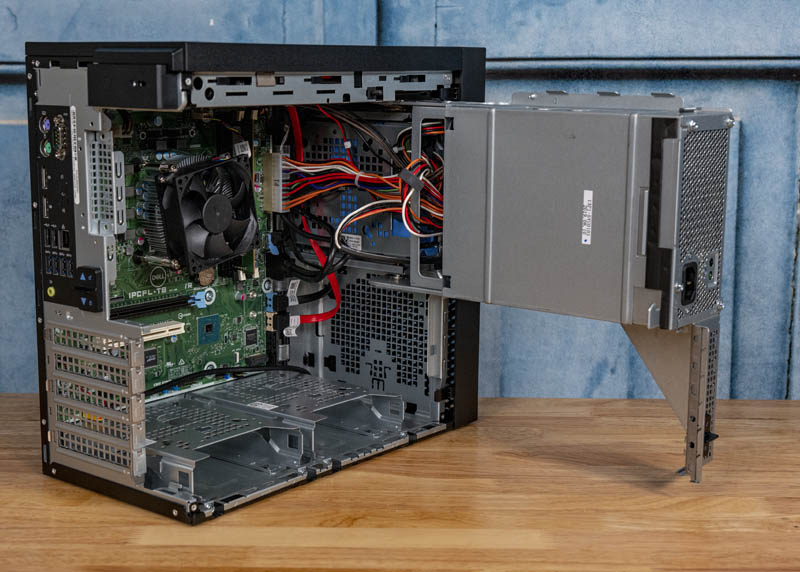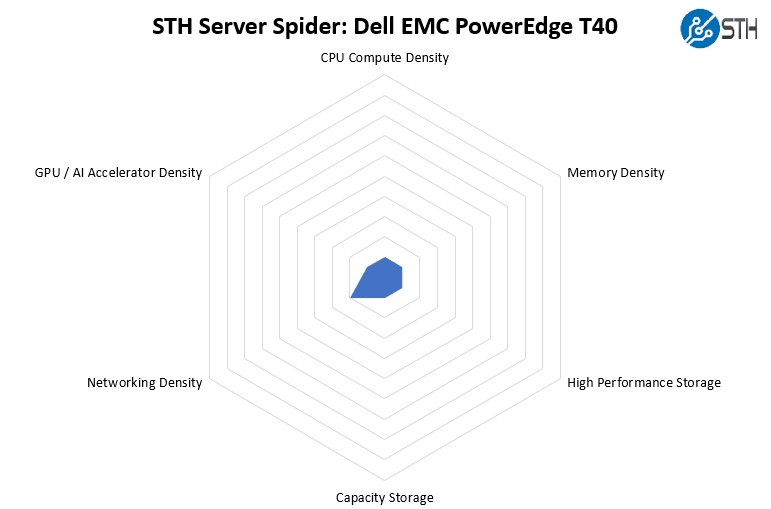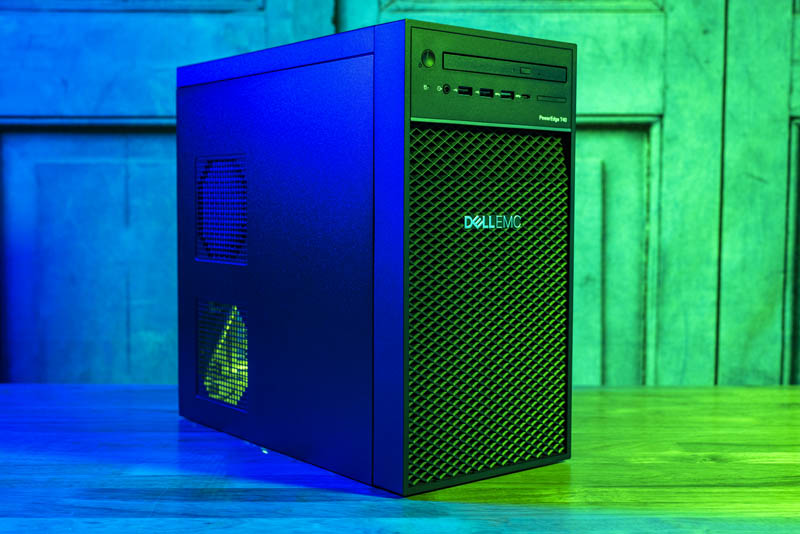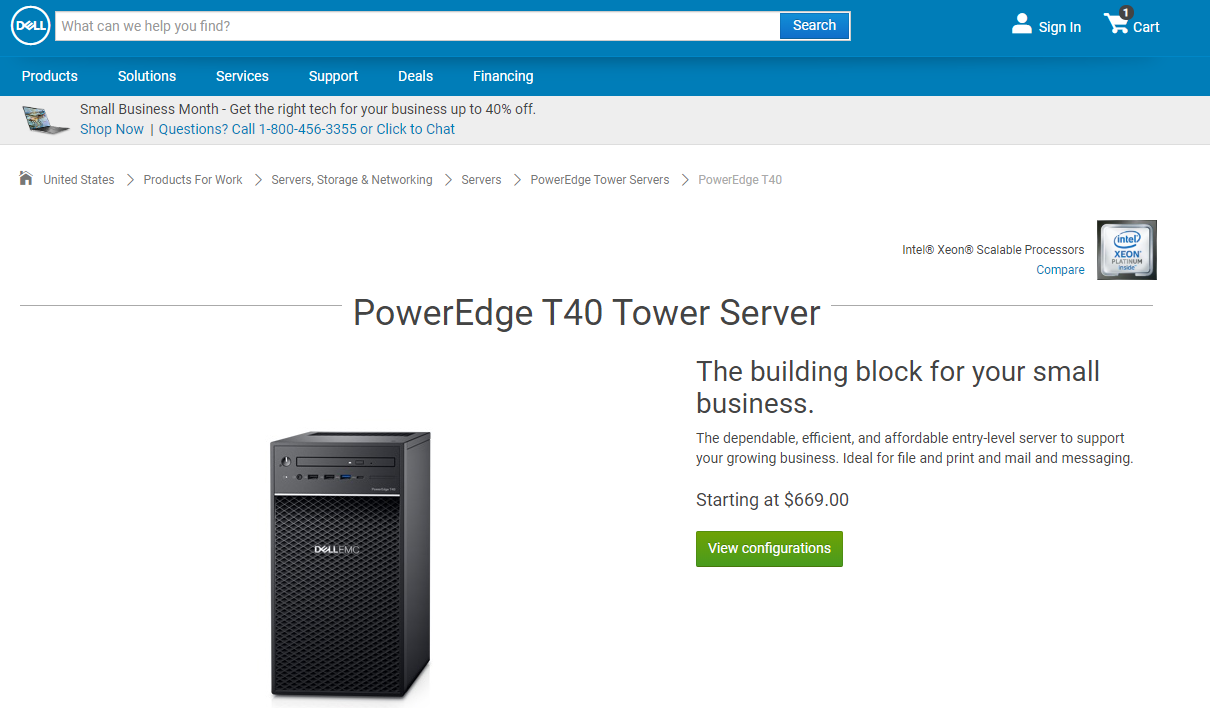Dell EMC PowerEdge T40 Power Consumption and Noise
With a 300W 80Plus Bronze PSU, one may immediately think this server is going to use a lot of power. That is not the case.
A big benefit of not having iDRAC is that idle power consumption is likely around 6W lower than it would be with the BMC. Since many of these systems are idle for much of the year, 6W adds up to $5-16 or so in annual power savings based on your electric rate (using $0.10-$0.30/kWh for that.)

At the top end, we were not able to get over 100W in our test configuration, and that took a lot of load. From a practical perspective, the 300W PSU has plenty of room for additional peripherals whether those are PCIe cards or extra hard drives.
On the noise side, the 7200rpm hard drive was probably the loudest item while this was in operation. Fans are relatively quiet and our test unit was well-behaved even under load. We normally test servers in the data center, but we see this as more of an edge computing device so we were also using 120V power. Dell has better servers for rackmount environments.
STH Server Spider: Dell EMC PowerEdge T40
In the second half of 2018, we introduced the STH Server Spider as a quick reference to where a server system’s aptitude lies. Our goal is to start giving a quick visual depiction of the types of parameters that a server is targeted at.

This is not a server that is designed for scale nor density. While there is not a lot of onboard networking, there is a lot of networking potential with the various PCIe slots. If one wanted a coax networking adapter from the late 1990’s there is even a PCI slot for that so we bumped the PowerEdge T40 up on the networking side based on the potential for networking density.
Final Words
Overall, the Dell EMC PowerEdge T40 is designed to be cheap. On one hand, it is effectively a workstation platform being sold under a server brand with a few points where it has been de-featured from the workstation side. Features such as iDRAC, a hallmark PowerEdge feature is missing as well. We also think Dell needs to provide plastic carriers for the 3.5″ drive bays. Converting the ODD bay to a SSD mounting point would also likely lower costs and expand flexibility. There are cost savings if you need a DVD drive, but these days we feel that could be better served via USB. We also would have liked to see features such as vPro support for the iKVM functionality, additional USB 3.0 ports from the Intel C246 PCH, and a functional M.2 slot.

At $669, the current price as of writing this review, the HPE ProLiant MicroServer Gen10 Plus is absolutely a better buy. Our HPE reseller (as of today) has the Gen10+ with 16GB of memory and a 1TB hard drive for $661 as the web price. One loses some of the PCIe expansion, optical drive, and the onboard GPU functionality with the HPE unit, but gains an extra drive bay, iLO, quad Intel i350 networking (higher-end), more OS compatibility, and twice the RAM. The HPE unit is also a fraction of the size, even including its external PSU. At $669 the PowerEdge T40 is very difficult to recommend. For a server that is effectively designed to be “cheap” if it is priced higher than its more premium competition, then pricing is missing the mark.

The other clear competitor seems to be simply buying workstations. There are lower-end workstations that support ECC memory. If one does not want ECC UDIMM support, given those modules are not as robust and large as the RDIMMs, then options expand significantly. For example, as part of our STH Project TinyMiniMicro Home Lab Revolution series, we purchased the Dell OptiPlex 3070 Micro for a few dollars less than this unit and that also came with Windows 10 Pro in a package around 1/15th to 1/20th the size. If one just needs low-power compute, does not need iDRAC, and does not need ECC memory/ lots of storage and PCIe expansion, then those 1L class PCs are excellent. That is a big opportunity for Dell to launch a true “micro” server.
Let us be absolutely clear, there are trade-offs. In a system like the Dell EMC PowerEdge R740xd, these trade-offs would be untenable. The PowerEdge T40 is a system designed precisely to make these trade-offs. Using a workstation-derived platform allows higher volumes to drive down costs. Not every feature may be present, but if they were present perhaps we would not get $349 specials. Under $400 this system presents an amazing value. It is significantly less costly than building a system of similar quality piece-by-piece.
Assuming you are looking at pricing for the PowerEdge T40 in the sub $400 range, then it is an excellent value that Dell did a great job designing. Since Dell pricing changes with promotions, we suspect the pricing to be lower than the $669 it is at the time of this review.




Hi Patric, love the article. One thing I need to point out. Yout T40 lower two hard drive mounts don’t use a blue sled type mount. Only the vertical 3.5inch mount uses a plastic insert.
I know this because my main system is a (late 2017 or ealy 2018) Dell XPS 8930 and it has the same chassis (as far as I can tell) as the T40. My XPS came with a hard drive in the bottom bay closer to the front. The hard drive screws into the metal cage with the old school style 4 screws from the sides of the HDD cage. You are able to reach these screws by taking out a drive cage by undoing the two screws holding each of the two cages to the larger case.
I double checked this was the case before posting this. As far as I can tell the metal parts are the same. Though oddly my unit came with SATA power routed to all three bays. The bottom two are fed by one power cord from the PSU. Email me if you want me to shoot over a photo. Also on page 16 (irl pg 31 on the pdf) of the Dell 8930 service manual it talks about the drive bays.
You forgot to include power figures. What’s the actual idle power consumption? What’s the actual MAX power draw? 6W lower is not helpful
In my opinion there are no servers without ECC memory. This is by far the cheapest option with ECC support and support for VMware ESXi. What a value!
I don’t think too many people will be trying to run VMware ESXi on a 4C/4T CPU on a machine with 64GB or less of RAM.
I definitely see the utility of a machine in this price category for Edge, SOHO, and SMB usage.
This looks exactly like the case of an Alienware Aurora R17 minus the AIO cooler and the flashy extra plastic bits.
Could you please further detail what it means that the T40 has AMT but not vPro? AMT by itself should be enough for out-of-band management, correct? What elements of vPro are missing, and does their absence somehow make OOB management impossible? Thanks.
As a “long-time” owner of a $400 T30, which uses a case similar to the Optiplex 980, I can say these machines are a mixed blessing. The motherboard and PSU on the T30 are BTX not ATX. You are looking at no possible upgrade path. The T30 is better equipped with 2x 3.5″ bays (blue sleds included, which can break/snap), 2x 5.25″ open bays and 2x 2.5″ spaces (not found on the Optiplex) after removing the DVD. However, I run it without side panel due to inadequate air circulation. They fit on their side on a rack shelf. This T40 looks much more crapped and have even less air circulation (holes cut in the side notwithstanding). The PCI slot is useful on the Optiplex 980 for GPU to regain use of both PCIe slots. A very old, used PCI NIC might find use in the Tnn boxes as they have working graphics without a dedicated slot. With a RAM upgrade and packed with drives, they can have some use running double duty with two guests on ESXi. Though upgrading a $400 box with no future is futility at best.
Engaging article I found, at the same time of looking to buy a workstation server with Xeon processor, for my home virtualization learning lab.
What time of the year should I expect a promotion from Dell on the PowerEdge T40?
Also, readers of this article, do you recommend I buy a brand NEW workstation server with medium specifications of a USED workstation server with higher specifications (for a home virtualization learning lab)?
Thanks
@Salama A. Dell has a July sales promotion every year and may have another in the winter (?). They also sell refurbished gear as available and have discounts/promotions on select items from time to time.
Regarding new vs used, a good part of the decision is your comfort level. Warranties and service are less available (or not), depending on source. You may find some better specs (e.g., memory or storage), but last years model will not have the latest CPUs and such.
I confused the T30 with the Optiplex drive bays. The T30 has 4x 3.5″ blue sleds (with 2x 2.5″ tucked away at top), and the Optiplex has 2x 3.5″ and 2x 5.25″ bays.
Another issue with these models is limited power supply connections. No GPU power (and unlikely the space for full-length cards) and only sufficient molex power for the supported drive configuration: no spares for extra fans. As the PSU is BTX, you need to botch an ATX PSU to replace it. Available SATA ports are limited to four on the T30 without an additional HBA card.
Also don’t forget: Dell disabled the M.2 slot which it inherited from the Precision workstations motherboard base. That takes away basically a full PCI3.0x4 slot from the already low amount of PCIe lanes of the small Xeons.
They did this as well in the T30 BIOS after version 1.02, but before it was useable.
In addition, the option for enthusiasts to throw in higher clocked/more core count CPUs seems not all to reasonable as cooling and airflow are limited. In the web, there are reports of noisy “Precision”-siblings with stronger CPUs…. and we know how much heat that CPU platform can generate under loading.
So, technically and value-for-money wise, the T40 is not very attractive to enthusiats like it was the case with the T20/T30.
I few very negative on this chassis which was reused among many Dell products (XPS, Alienware Aurora, etc…).
The major flaw is the poor CPU thermal dissipation. The CPU fan is block by the PSU. Meanwhile, the front HDD blocks the air flow from another angle.
A second flaw is lacking of HDD bays. It is OK for office or gaming machine, but not accepable for server.
Is VMware ESXi supported on the T40?
Which is good server for virtualization –
Dell PowerEdge T40
and
HP ProLiant ML10 v2
I have the same questions as Christos So and Nitish Jamudiya. Can some one share their experience when running ESXi on these server?
ESXi 7 running like gem, without any issues. I have the e-2224G + 64Gb non-ECC RAM from Crucial. I have a 2 node vSphere cluster driven by 2 Dell T40 with the same configuration.